NOTE: I’d like to offer a special ‘thanks’ to Lillie Keener of Salt Lake City for her contributions to this story. Lillie grew up in Moab and lived with her “Moab Mom and Dad,” Troy and Jaunita Anderson. The Andersons became good friends to Jack Holley over the years and Lillie has shared many memories with us. In addition, many of the photographs in this article (some being published for the first time) come from Lillie’s personal collection. We cannot thank her enough.
Also thanks to the Utah State Historical Society and Indiana University, who allowed us to share images from their archival collections..JS
In the summer of 2016, one of the busiest highway intersections in southeast Utah is the junction of US 191 and Utah State Road 128, just south of the Colorado River. The ‘river road,’ as it’s been called for more than a century, parallels the Colorado for 30 miles and ultimately connects with I-70 to the north. Thousands of tourists, coming from the east, exit the freeway near Cisco, Utah and take the slower, winding “scenic route” to Moab. Many thousands more stick to the main highway, coming from all points north, west and east. They all converge on this beautiful junction.
A few years ago, the traffic coming from both directions became so congested that the Utah Highway Department installed a stop light. On busy weekends, traffic can be backed up for miles, in both directions, from that light. It’s called gridlock.
Enhancing its 21st century appeal to tourists and recreationists, in 2013 the intersection officially became the “Lions Park Transit Hub.” The multi-million dollar project provides a gathering point for bicyclists and links riders to the Colorado River Elevated Bikeway and points upriver. “Bouldering’ rocks and other amenities were added to attract even more visitors. On busy weekends, the place is jam-packed.
Moab itself resembles the highway these days. Overcrowded and overpriced, housing prices have skyrocketed and many of the town’s lower income citizens struggle to find affordable living in a community overstocked with expensive homes and time-share condos. A few years ago, some Moabites sought some semblance of normalcy, setting up homes in trailers and old buses along the river and Kane Creek Road–the old “Egg Ranch Road.” There was simply nowhere else affordable for them to go.
But the Grand County Council said they were in violation of its land use code and the trailers and buses had to go. The code requires sanitary facilities within 200 feet of primitive camp sites, but it was impossible to comply because the property where the old mobile homes were located is in the Colorado River’s flood plain. The owner of the property appealed to the government on “humanitarian” grounds, noting “they’re human beings. You’ve got to deal with them.”
But rules are rules. Eventually at least twenty people were uprooted from their homes and forced to leave.
In 2016, it’s almost impossible to fathom how transformed—how transmogrified—Moab has become in these last few decades. It bears little resemblance to the Moab that a dwindling few still remember, or the Lost Eden that so many still long for.
But go back eighty-five years, to the summer of 1930. And meet the “Goat Man of Moab.”
His name was Jack Holley and for three and a half decades, he was the first man travelers saw when they came to Moab, and the last man they waved goodbye to when they left. Jack came to be known as the Goat Man for the small herd of goats that were always by his side.
Holley lived a hermit’s life in a small stone and wood dug-out shack; he loved his peace and solitude, though he was dirt poor, even by the living standards of the 1930s and the Great Depression. His bare-bones existence meant he had no significant debts, no mortgages, no insurance payments, no credit cards, no utility bills. As far as we can tell, he paid no taxes and, other than a small veteran’s benefit check that came each month to the Moab post office, he had no income.
And yet Jack Holley seemed at peace with the world. He lived a life as simple and free from the cares and woes of the world as is imaginable. He was always happy to visit with friends and strangers alike and waved to all passersby. He loved animals and surrounded himself with his beloved goats and a family of dogs as well.
He lived mostly on the wild plants and vegetables he found along the river and, in fact, probably devoured most of the wild asparagus that once grew prolifically upstream from his cabin. And, of course, the Goat Man depended on the generosity of his friends in Moab, who regularly brought him food and clothing. He had many friends who cared about him and for him. For many Moabites, Jack Holley was ‘family.’
* * *
How did Jack Holley wind up in Moab? Over the years, Moabites who visited the Goat Man listened to his stories and pieced together a history of his life. No one spent more time with Jack than Jaunita Anderson. She and her husband Troy lived in Moab for almost twenty years and ran Vogue Cleaners on
First East; Jaunita was a frequent visitor and a regular supplier of food and supplies for Jack. Over the years the Goat Man told Jaunita a remarkable tale of his extraordinary life. Whether these details are hard facts or his fanciful recollections, nobody can say. In the end, it doesn’t matter
But according to Jaunita, Jack Holley was born in Crawford County, Arkansas on May 7, 1876, to Louis Burr Holley and Stella “X,” a full-blooded Cherokee Indian. According to Juanita’s recollection, “Mr. Holley was one of the fighting forces during the Spanish American War, serving with the U.S. Navy during World War I, and spent many years with the Merchant Marine, transport service and various fishing operations. He had many stories to tell of his adventures on the high seas, sailing around the world three times, and three times surviving shipwrecks. He had also been a watchmaker in Switzerland at one time during his life.”
Jack and his brother arrived in Moab in 1930, in search of mining properties. But Holley’s health even then was weakened by several bouts of malaria that he’d suffered during his world travels. Not long after they arrived in Utah, “the untimely death” of his brother (that’s all we know of his passing) left Jack Holley stranded in Moab, in ill health and apparently penniless. In 1930, he would already have been 54 years old and after a hard life on the high seas, Jack Holley was an old man.
But somehow, by his own wits and the assistance of newfound friends in Moab, Holley hung on. He built a crude stone dugout cabin and scavenged enough wood and tar paper for a roof. Whether he constructed the cabin by himself or had help is not known. But clearly, from surviving photographs, Holley’s cabin was tiny. For the next 25 years, it was home and Jack Holley became Moab’s hermit greeter. Tourists frequently paused to say hello and to photograph this most unusual man, and in fact, he became something of a celebrity. Jaunita Anderson would later write, “Because of the pet goats he harbored as pets he had been affectionately christened ‘The Goat Man,’ by tourists and writers with whom he visited.”
During that quarter century in Jack’s first crude stone cabin, imagine how much the world changed. Just months before his arrival in Moab, the stock market had collapsed and the country spiraled into a Great Depression. In fact, millions of Americans, across the continent, would eke out similar lives on the margins. And yet, despite his isolation, Jaunita Anderson remembered that Holley was more informed about national and world affairs than many other Moabites she knew. Photographs of Jack taken in the 1940s reveal a stack of newspapers on the outside table by his front door. He read everything he could get his hands on. And Jack claimed he could fluently speak in several languages.
He had only been there a couple years when Franklin Roosevelt was elected president. In 1937, a Civilian Conservation Corps (CCC) camp was established by FDR at Dalton Wells, a few miles north of Holley’s shack. Less than a decade after Jack came to Moab, the planet erupted in world war and Holley found himself with a neighbor for the duration of the war.
The Colorado River Bridge was considered a possible target for an enemy attack, as it was the only river crossing downstream for more than 500 miles. A 24 hour a day security checkpoint was established on the north side of the river and a small shack was built to house the staff. Ironically, a freak rockfall killed the watchman. The local paper reported, “George Otto Ellis, 52, watchman at the Moab bridge over the Colorado river was killed instantly about 7 oclock Tuesday morning when a rock weighing perhaps 50 tons fell from a cliff at the northern end of the bridge falling squarely on the watchmen’s shanty and and smashing it to kindling wood. Mr Ellis who had just gone on shift was reclining on a cot inside the house. He was killed instantly his body being terribly crushed.”
Holley’s cabin was barely a hundred yards away. He must have heard the rockfall and was no doubt one of the first men on the scene of the fatal accident.
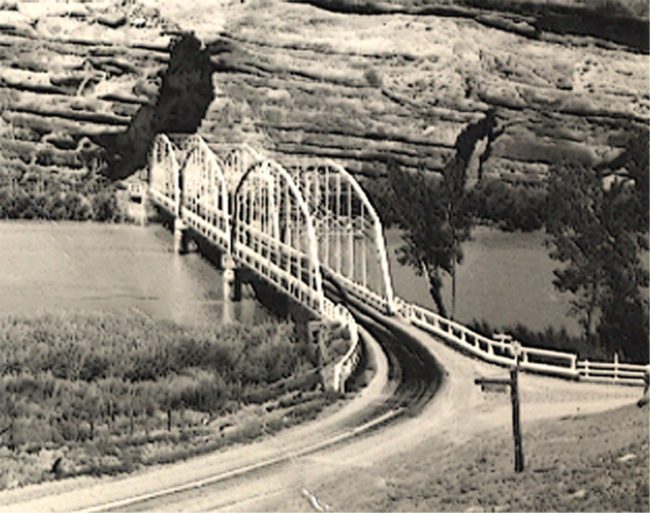
‘Jack Holley’s cabin would have been just below the bottom of this old Harry Reed postcard, on the right side of the road.’
* * *
When the war ended in 1945, life returned to normal in Moab, at least for a few years. Southeast Utah remained one of the most isolated parts of the continental United States. Still, the more adventuresome wandered through Moab, including Herb Ringer (whose photography has been features in The Zephyr for almost 30 years). In early June 1950, Herb and his parents, Joseph and Sadie Ringer, crossed the original river bridge and paused on the south side to take a few photographs. As he returned to his Ford Woodie, Herb turned to see an old man in faded blue overalls, with scruffy white hair and whiskers, surrounded by goats. Herb stopped to chat and Jack kindly obliged to be photographed.
A couple years later, Charles Cushman was traveling west through Utah and also encountered Holley. Cushman took several photos of the Goat Man and his clan. It was November 4, 1952. The nearby cottonwoods were still a brilliant gold, the air was cool but mild, the sky a brilliant blue. Later that evening, Cushman would learn that Dwight Eisenhower had been elected the country’s 32nd President. No doubt Jack read about it the next day.
(Cushman’s images of the West are catalogued at Indiana University. Click here to see more about Cushman and his remarkable collection.)
While Moab still seemed peaceful that late autumn afternoon, all hell was about to break loose. The previous summer, a Texas geologist named Charlie Steen had discovered uranium in the badlands northwest of Moab and by the following summer, Moab had become a boomtown. In a year the tiny community’s population exploded beyond its capacity and prospectors and their families were setting up camp wherever they could find a level spot and a bit of shade. The edges of the old highway were choked with the temporary homes of wannabe mining magnates. Most left empty-handed, but the boom changed Moab forever.
For one thing, the heavy traffic quickly made the old one-lane bridge obsolete and, in 1955, construction of a new modern span commenced, a couple hundred yards downstream. The new bridge meant re-aligning the highway and Jack’s old cabin was in the way.
Had Jack’s dilemma occurred in 2016, it’s hard to imagine a happy outcome to this story. Like the Kane Creek residents a few years ago, who were removed from their homes for code violations, the Goat Man would have surely faced immediate eviction. But as we like to remind ourselves, “things were different back then.”
Though in many ways life for many Americans was much worse in ‘the good old days’—consider how well an African-American hermit with goats would have fared in 1930—life was at least less regulated and rule-happy. The Moab of 1955 found a way to resolve Jack Holley’s dilemma.
The Utah Department of Transportation had constructed a shed to store tools and other equipment during the bridge construction; once the work was done, they had no further use for it, so they gave it to Holley. UDOT relocated the shed to the west side of the new highway, just south of the new bridge. Eventually, even a power line was strung to the front of his new home. Though it was never wired inside for electricity, at least, after twenty-five years, Jack Holley had a porch light.
* * *
Lillie Keener, who was raised by her “Moab Mom and Dad,” Jaunita and Troy, has many fond memories of the Goat Man’s last decade in Moab. By now he was in his early 80s, but still surrounded by his goats and his dogs. Someone gave Jack a transistor radio and he played it often. Lillie remembered that “he loved coffee and smoked Camel cigarettes all his life.” Though he had electricity outside, he still used coal oil for his lanterns and mostly burned wood in his old cast iron cook stove. Her dad would bring him coal in the winter.
And, according to Lillie, once a year her family was able to persuade Jack to come into town for a home-cooked meal. This dinner also marked the occasion of the Goat Man’s annual bath! It was a condition Jaunita insisted on, if they were to gather together at their dining room table. There are several stories about Jack’s personal hygiene habits, or the lack of them. It’s said that he often invited passersby into his little shack for a cup of coffee, but the interior of his shanty was a bit…overwhelming. Those same people rarely accepted the invitation twice, choosing instead to drink their coffee outside..
But despite his ‘ripeness,’ he was visited frequently. One Moab resident of the late 50s remembers that Jack offered some of his goat milk for her newborn, when the baby kept rejecting the formula.
LaRita Lemon McFarland and her family used to visit his cabin on holidays and bring him presents. Others simply remember waving as they passed by–he always waved back.
Robert Buckingham of Moab recalls, “I used to run into him in the morning run to the post-office with my Grandma Nellie. He was always very congenial and liked to talk. The thing I remember most was his appetite for wild ragweed! He said his goats liked it as well!…He never said how he fixed it ( raw I guessed) but he would talk about all of the things that grew wild that were edible. I suppose the first vegetarian that I ever met! A man ahead of his time.”
Lillie thinks he ate meat occasionally, but since he had no way of refrigerating it and little money to buy it, he lived mostly off the land. Jaunita brought him pies but he never bought meats when he made his annual trip to the grocery. For 35 years, Jack Holley stuck to his routine.
In late July 1965, Holley was 89 years old and still ‘living the hermit’s life.’ But one night a fire broke out in his shack–most likely set by one of his smoldering Camel cigarettes–and the Goat Man was badly
burned. The Moab Fire Department responded, put the fire out before it destroyed his home, and transported Jack to Allen Memorial Hospital. The Andersons soon learned of the fire and Jack’s injuries and visited him often, but about two weeks after the fire, he developed pneumonia and on August 8, 1965, Jack Holley died.
Of course, he died penniless, but Jaunita Anderson was determined that Jack be remembered. According to Lillie Keener, “He would have been buried in an unmarked grave so mom took charge and had a viewing and funeral for him and buried him in our family plot. She felt he was important to the history of the community so she got his headstone with his picture and had it engraved with ‘Goat Man of Moab.’
Jack didn’t leave a will and didn’t even own the land where he’d lived for 35 years, but nobody seemed to mind. Lillie recalled, “Mom and Dad went through his belongings when he died…collected a few mementos like some of his watches. But he really didn’t have anything of value. We took one of his dogs to our house and dad gave the goats..chickens etc to someone in Spanish Valley.”
Her dad recovered a couple packs of his Camels. “That’s how I know he smoked camels, because Dad kept a couple packs for years in his desk…I remember him telling me they were Mr. Holley’s.” And finally, they saved a photograph of Jack that somehow survived the fire. It must have been a favorite of the Goat Man’s and was pinned to the wall near his bed.
I arrived in Moab more than a decade after The Goat Man’s passing. He was a topic of conversation even then. There were stories that Jack had left behind a small fortune in gold coins and had buried his secret stash nearby. Treasure hunters scoured the area for years, hoping to strike it rich, but found nothing. The original stone cabin, the one he called home from 1930 to 1955, disappeared decades ago, though some of the original stones could still be seen. In the 1990s an aerial tram was constructed, just south of the cabin site, but never opened for business. Today it’s still there, rusting and abandoned. And in 2013, construction of the Moab Transit Hub began in earnest and the rock outcropping that was, in fact, the north wall of his home, was completely removed and the entire site leveled to make way for a parking lot. No trace of Jack Holley’s life by the river survives, not even the topography.
As Moab of 2016 sprints recklessly, almost uncontrollably toward an uncertain future, characterized by never ending change, constant growth, and in many cases, shameless greed, remembering people like Jack Holley and the simple life he chose to lead gives me some comfort.
Perhaps just as comforting is this— Jack Holley was a unique character with a very alternative lifestyle. Jack was ‘different,’ to be sure. But those Moabites who encountered him over the span of three and a half decades not only tolerated those differences, but embraced them. And eventually even celebrated them. Today, eighty-five years after The Goat Man came to Moab, he is still remembered and loved. And missed.
Jim Stiles is Founder and Co-Publisher of the Canyon Country Zephyr.
Click Here to see the full collection of Goat Man images from Charles Cushman
Click Here to see the full collection of Goat Man images from Al Morton
Click Here to see the full collection of Goat Man images from Lillie Keener.
To read the PDF version of this article, click here and here.
To comment, scroll to the bottom of the page.
Don’t forget the Zephyr ads! All links are hot!

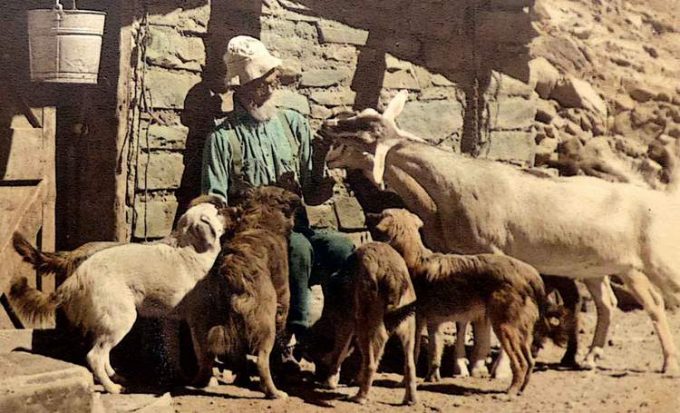
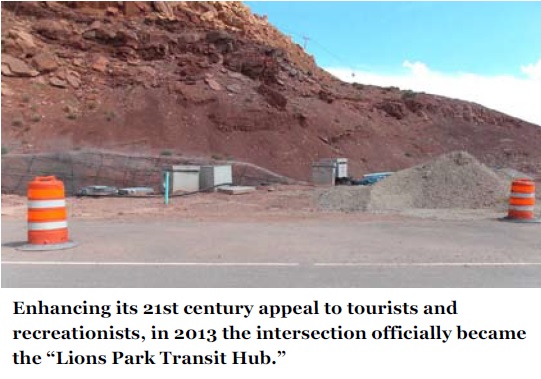
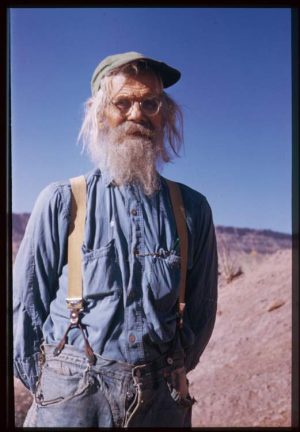


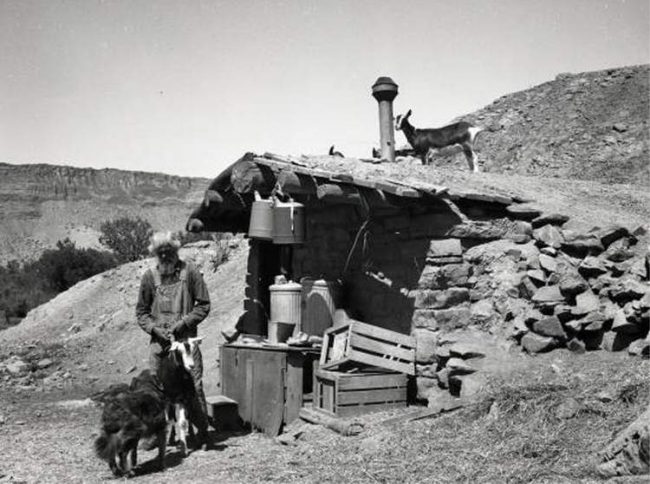

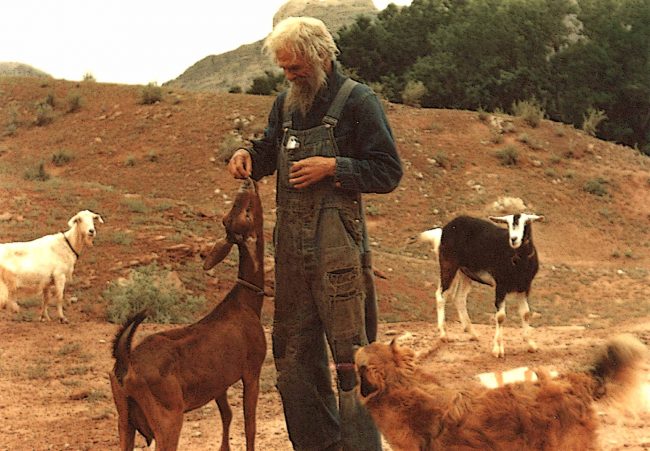
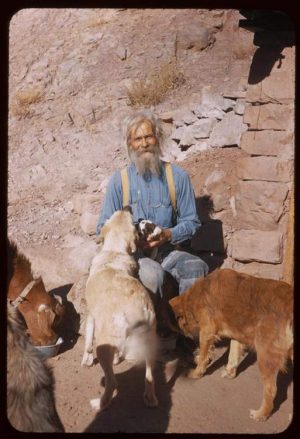

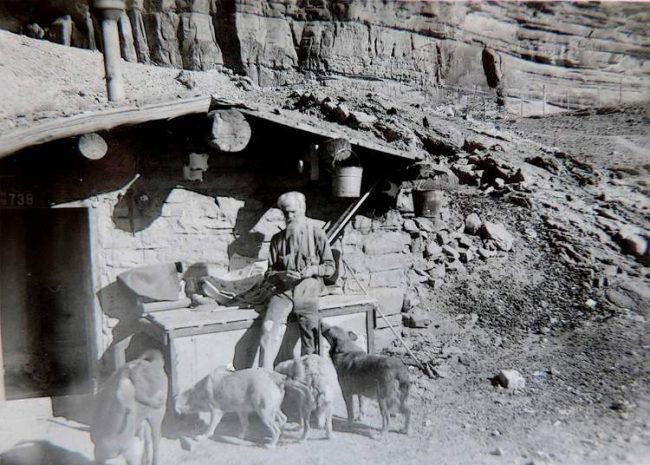
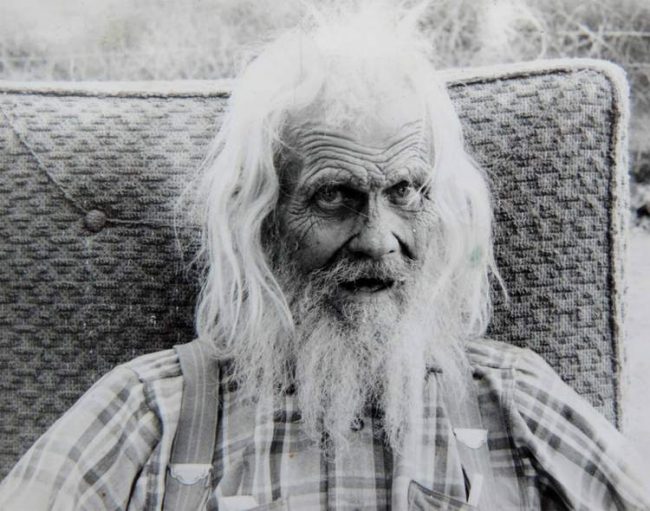
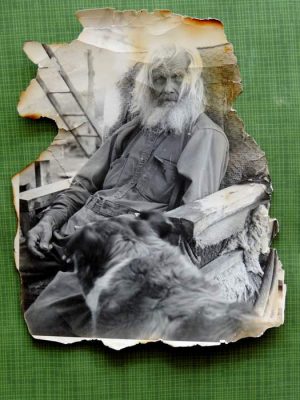
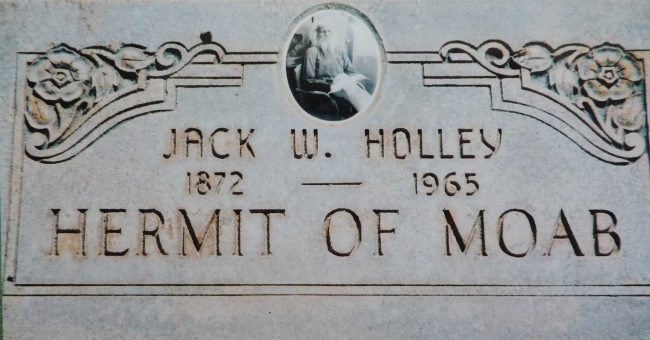


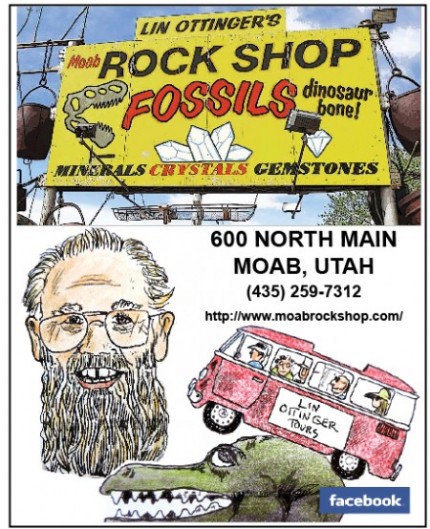


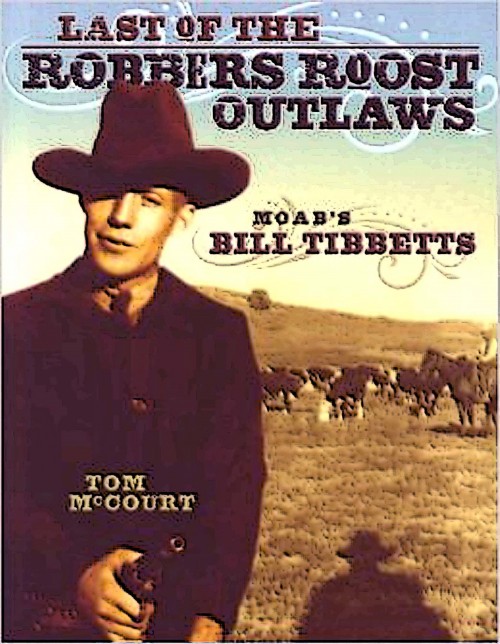


Wonderful article. Thank u for honoring his life and allowing us more insight into his world. He was a treasure and a gentle sould.
I remember seeing and visiting with Mr Holley outside the csnyonlands cafe in the sixties. We were mesmerized by h. Such a wonderful chsrecter. I’m so glad I had the opportunity to meet this man.
What a great well written article on Mr. Holley, I remember him well.
Jack also had a number of cats that lived in an adjacent woodpile. Unlike his dogs and goats, they were wild.
I wanted a cat and Jack said I could have one if I could catch it. I left some time later, wounded from my efforts and sans cat.
My parents Fred and Winifred Knecht and I lived at the Doxol plant close to Jacks place by the river. My dad would often walk over to visit with him. When Jack needed to go into Moab to buy groceries, my dad took him. He bought bananas for the goats and hamburger for his chickens. He had a lot of coffee that he loved to drink and always offered it to his visitors. We gave him a black puppy named Elsa. He loved her and she went everywhere with him. Sadly one day, she went on the highway and was run over by a car. His tears really flowed for that sweet dog of his. Once we invited him to dinner and of course my mother did an extra well planned meal for him. He came over and ate, but said it was to much for him. Once he even had us take care of Linda a young goat that the Billy kept bothering as males goats do. We kept her for awhile until Jack figured out what to do to keep them apart. I guess it didn’t work because she had a kid not long after he took her back home. He gave me a kitten once when I went with my dad to visit him. I had her for many years. When the fire burned him so badly my dad visited him in the hospital. But he didn’t remember him anymore. I guess he had dementia by then and also the pain from the burns he received from the fire. He may have had money stashed somewhere because he only bought what he needed. I dont think it was good coins but just regular money he received from the government. He as a dear man and considered a genius and I will always remember this man that never did mind being different and I can just imagine what he would think of this world we live in today. He was never “The Goat man” to us but Jack a dear sweet man that was our dear friend.
Thank you for telling his story. This article says he died in 1965 which means I would have been 5. I have very clear memory of always seeing him with his goats. That is quite an impression on a small child. Still makes my heart Happy when I think of him. I think that his name “the goat man” was not a mean nick name, more out of respect than anything else, at least for our family. I grew up on White Ranch first staying with my Grandpa George White then later living there with my dad Tommy White. They always spoke kindy of him even after his passing. And I seem to remember that my grandfather George was friends with him because my grandfather was one of the early workers for UDoT maintenance of HWY 128.
Stiles’ biography weaves in and out of the changes in Moab with the staunch and hermit-like lifestye of Holley, He reminded me of the stories I’ve heard of mystics meditating in caves in India and Tibet. I hope it encourages people to look into the local stories captured by oral histories in their libraries or historical socieites and make them into stories like this one,
He was a remarkable man. His simple lifestyle reminds me that I am too dependent on artificial conveniences. He teaches us lessons. We need to simply our lives. Solitude is sometimes desirable.
My aunt and uncle lived in Moab when I was a kid, and I remember passing by the goat man’s place on the way in and out of town. We would come to Moab for Easter or Thanksgiving. Thanks for this article, I was thinking about him a while back after reading some of your Moab stories. Never knew much about him before. The world is poorer with the loss of characters like the Goat Man of Moab…
Thank you reminding us of some some of the people who Make Moab what it is today and tweaking our memories.